How to Plant a Good and True Tree
Steemian's all, are you happy with gardening?
Like to plant crops?
But the results are less satisfactory or even even the plants you plant often die? Not fruitful?
Try steemian's follow the steps I wrote below.
This time I will exemplify the way of planting kelengkeng tree. The same way of planting for fruit or vegetable crops as well as ornamental plants. Either dilahan open or dipot.
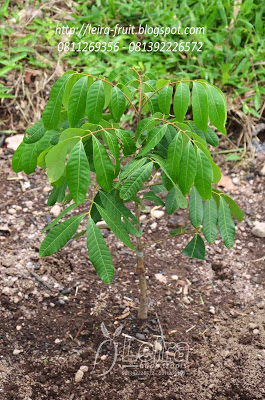
Klengkeng "Wusan" after planting on the land
Watching fruit plants that grow healthy and strong and able to bloom and bear fruit optimally become a dream that is expected by all people who grow fruit crops, be it in the yard or in the garden land specially prepared for it. Generally before and during the rainy season arrives, the movement of plant seeds will feel amazing because in droves people take advantage of this good moment to immediately buy and plant fruit seedlings, not even a few people who prepared the seeds long before to get the seeds Which thrives and is ready to be moved immediately to the land or kebu
Initial preparation to be done before planting other than good seed preparation is the preparation of making the planting hole that seems very trivial, but a small mistake in making the planting hole will greatly affect the quality of subsequent plant growth. The effect will last for a very long time and is very likely to cause the growth of plants is not as expected (slow growth, nutrient males, long waiting time for plants to cultivate, plants susceptible to pest attack, etc.). Therefore the planting hole should be well prepared, as well as we prepare the seeds before planting.
Planting management begins by modifying the root growing space at the beginning of plant growth by providing an ideal growing space, especially for root growth. Generally planted seedlings are small seedlings, less than 1.5 meters even the size can be even smaller, only 0.5 meters for example.
Like growing infants or toddlers, the growth environment is critical, meaning a good growing environment will support seed growth for the better, vice versa. By providing an ideal growing space, plant roots will grow optimally to support the growth of plants on the ground. Good quality root growth manifestations are reflected in healthy and strong plant growth, and on the contrary the quality of plant growth will be slow and ugly if root growth in the soil is inhibited.
Here are the steps in the management of planting holes:
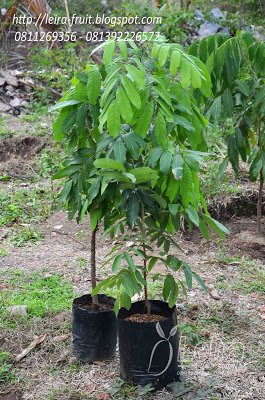
Prepare fruit plant seedlings to be planted first. The height of the seedlings (in meters) is not an absolute thing, but it is advisable to plant large enough seedlings with a seed height of at least 1 meter, especially if the seeds are to be planted in a field or garden far from the planter's domicile and not supervised Full every day. Large seedlings of course have relatively larger stems with root systems that have grown well and enlarged so as to sustain overall plant growth post-ground planting. But if you want to be planted in the front yard / back of the house, the seeds are small also not a problem because it can be monitored and cared for every day, ranging from watering (if no rain), weed control around the roots, fertilization, and pest and disease Attacking plants.
Determine the point of planting in the yard or garden by considering the desired spacing (related to the population of the plant per unit area). Clean around the prospective planting hole from the grass, garbage, or rock that may be there.
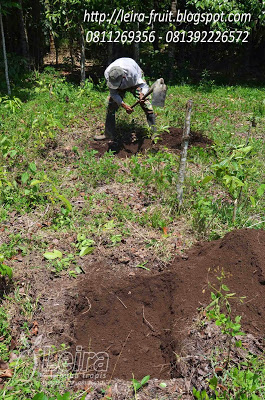
Dig a planting hole with a minimum size of 50x50x50 cm for small seedlings (height 0.5 meters), the size of 75x75x75 cm for medium-sized seedlings (height 1 meter), and the size 100x100x100 cm for large-sized seedlings (height of 1.5 meters or more)

Clean the planting holes that have been made of stone, gravel, the rest of the roots, as well as other impurities so that the planting hole looks clean and tidy.
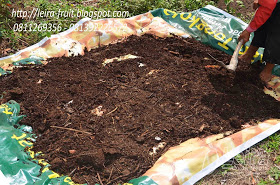
Sprinkle phosphate fertilizers in the form of Rock Phosphate (RP), Triple Super Phosphate (TSP), or SP36 (Super Phosphate 36), at the bottom of the planting hole as much as 100 grams for the planting hole the size of 50x50x50 cm, 150 grams of the planting hole the size of 75x75x75 cm , And as much as 200 grams for planting hole size 100x100x100 cm.
'Phosphate is needed plants to establish roots and root system strong at the beginning of plant growth, and the provision of phosphate, a significant amount at the time of making the planting hole will greatly assist in the provision of phosphate, are the roots and young plants as a whole, so that the plants will grow Better and faster.
Prepare manure (pukan) in the form of manure (kohe) mature and fermented perfectly in sufficient quantities, depending on local soil types. For heavy clay soil types with high clay fractional fractions, one to 1.5 parts of the / kohe composition may be mixed with 3 parts of soil. For medium soil types with clay fraction, dust, and balanced sand, can be mixed 2 parts of the pure / kohe with 3 parts of soil. While on the soil with high sand fraction content, using 2 to 3 parts of the composition / mixture is mixed with 3 parts of soil.
As has been discussed at length in the previous post (Media Plant Tabulampot), the giving of organic material in the form of puk / kohe will help a lot in increasing the amount of soil organic matter, improve the structure of the soil become more crumb (crumb) so that it becomes the ideal root growth place , Root development becomes faster and can spread well in a shorter time. Provision of manure can also ensure the availability of essential macro and micro nutrient supplies from the reshaping (decomposition) of organic materials at the beginning of plant growth in the field. In addition, the provision of organic materials means creating an excellent environment for microbes (microorganisms), both within the pitch itself and within the soil. From the good environment will greatly help the process of overhaul / decomposition of organic materials that produce so much essential macro and micro nutrients as mentioned above.
There is no standard / good type of pok / kohe to be used as a mixture of soil in the planting hole, but it is better to use livestock / kohe derived from ruminants (cattle, buffaloes, goats, sheep) as well as horses and rabbits. Do not forget to use perfectly decomposed gutters (less than 15% C / N ratio) to avoid a burning effect that could cause plant death.
If necessary, do soil filtering of planting holes using a straw wire filter with a 1 cm sieve hole size, the use to separate small (gravel) rocks as well as other impurities that may be present in the soil (plastic waste, wood pieces, etc.) which Can disrupt the growth of young plant roots.
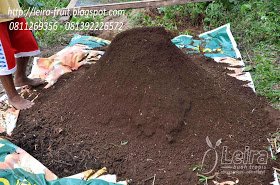
Soil and pit / kohe with appropriate volume ratio ready for stirring
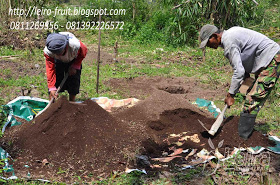
Perform stirring evenly manually at the mixing of soil and the / kohe and repeat the mixing and stirring process for 2 to 3 times so the soil and the soup / kohe can be mixed perfectly to form a homogeneous mixture.
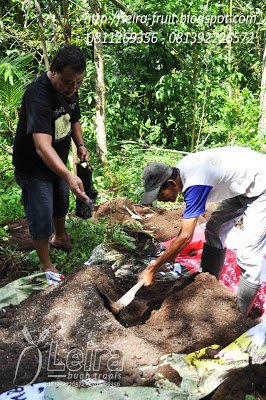
Combine phosphate-containing fertilizers in the form of TSP (Triple Super Phosphat), SP36, and RP (Rock Phosphat) fertilizers, with amounts adjusted to planting sizes ranging from 50 to 150 grams per planting hole, given at stirring Ground with puka / kohe. This phosphate-containing fertilizer serves as a good starter for early growth of plant roots after planting in the soil, thus the roots will grow more and more strongly to support the growth of plants on the land.
.jpg)
Reinsert the soil mixture / kohe into the planting hole to the height of the root neck of the seedlings to be planted. Solid soil on all sides of the side of the hole to avoid landslide effects if splashed or exposed to heavy rain, so that the seeds are planted does not change the position after the seedlings are planted.
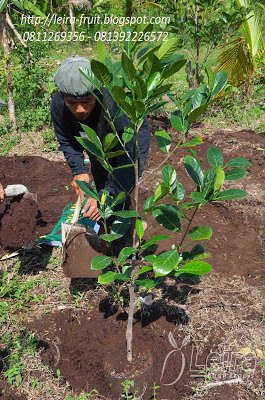
Tear off plastic and remove seedlings from polybag plastic, place the seeds in the center of the planting hole with adjustable depth. Reinsert the mixture of soil and Pukan / Kohe around the hole, cover all the roots of the plant to limit the recommended height is limited to the neck of the seedling roots and do not reach the point of connection (if derived from the seeds grafting or grafting insertion or grafting).
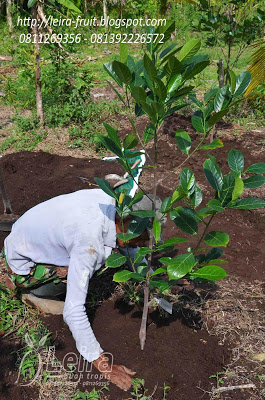
Tighten the soil around the seeds so that the seeds stand upright, not tilted to one side that can cause the growth of the plant becomes ugly in the end.
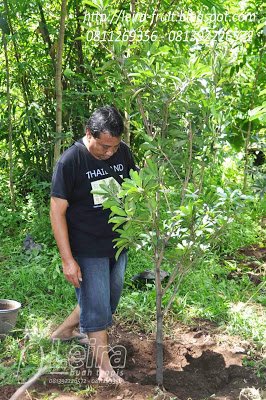
Compacting of soil around the plant is necessary so that the plant can stand upright and sturdy. Mixture of soil and manure in sufficient quantities will be very loose so that even when pressed and trampled during compaction, the soil will remain loose. In addition, soil compaction also aims to fill all the niche on the side that may not yet filled by a mixture of soil and manure so that can be avoided soil perforated when planting holes splashed with water.

Immediately pour water in sufficient volume (10 - 20 liters) to the plant so the soil becomes wet and saturated by water, while avoiding the plants to wither after planting. It is advisable to start planting at the beginning of the rainy season so that the plants get a continuous supply of water so the plants can grow fertile. However, it is possible to start making planting holes and planting in the dry season provided that there are sufficient water sources for regular watering.

Sprinkle lime dolomite that contains elements of calcium and magnesium to maintain a stable pH (degree of acidity) of the soil while providing nutrition for young plants grown in open fields. Giving dolomite lime is important for plants, especially in the process of forming new shoots for young plants and supplying magnesium nutrients that become the main constituent of chlorophyll in the leaves. It is hoped that soon the plant is able to photosynthesize perfectly so that plants can grow well in the field.
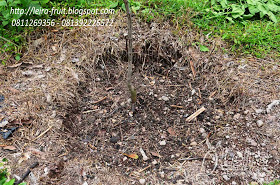
Another important thing after planting is done is weed control, especially if the land is in a distant place. The growth of young plants is strongly influenced by the competition with weeds that grow rapidly around the young plants. Competition of young plants with weeds more towards the seizure of nutrients and water that are critical for these young plants. Immediate control the growth of weeds by weeding manual / mechanical if the number of plants are few and close with a range of places to stay, but if the number of plants is quite a lot in that distant land, perform chemical weed control. Use herbicide (weed killer) active ingredient glyphosate isopropyl amine (example: Roundup, SunUp, Rambo, Basmilang) mixed with the herbicide active ingredient 2,4D amine (example: DMA6, Lindomin) with a measure to follow the advice on the label herbicide. The combination of two herbicidally active ingredients is able to control and suppress grass weed growth and some broadleaf weeds within the next 2 to 3 months. The next chemical weeding can be done by looking at the succession of weeds that grow in the same place.
In certain cases, the planting hole is prepared much earlier before the rainy season arrives, approximately 2 or 3 months earlier while waiting for plant seeds to grow larger and healthier in polybags. Put the mixture of soil and manure into the hole until it is almost full, do not compacted because the planting medium will drop by itself into the hole. Give the bamboo bamboo center of the planting hole to mark the point of planting if the rainy season has arrived or when the seedlings are ready for planting on the land.
If it is time to plant, remove the bamboo marker and center hole as big as the size of the plant poly bag, insert the plant in the hole and then settle the soil around the root ball with the ground. Finally, flush with water until saturated and the plant is ready to grow bigger and healthier in the field.
So the article from me, hopefully be your reference.
Hopefully this article will inspire us to plant, green our earth again. In an effort to reduce air pollution that is getting worse, with tree felling and so forth.
Come plant!
Always follow and upvote me @madcool.
I love your post, thanks for sharing! I gave you a vote. I hope you enjoy it.
Downvoting a post can decrease pending rewards and make it less visible. Common reasons:
Submit
Thanks you...
Downvoting a post can decrease pending rewards and make it less visible. Common reasons:
Submit
Hi! I am a robot. I just upvoted you! Readers might be interested in similar content by the same author:
https://steemit.com/education/@madcool/how-to-plant-good-and-true-tree-3
Downvoting a post can decrease pending rewards and make it less visible. Common reasons:
Submit
Congratulations! This post has been upvoted from the communal account, @minnowsupport, by madcool from the Minnow Support Project. It's a witness project run by aggroed, ausbitbank, teamsteem, theprophet0, someguy123, neoxian, followbtcnews/crimsonclad, and netuoso. The goal is to help Steemit grow by supporting Minnows and creating a social network. Please find us in the Peace, Abundance, and Liberty Network (PALnet) Discord Channel. It's a completely public and open space to all members of the Steemit community who voluntarily choose to be there.
Downvoting a post can decrease pending rewards and make it less visible. Common reasons:
Submit
Postingan yang sangat menfesankan. Saya sangat suka.
Downvoting a post can decrease pending rewards and make it less visible. Common reasons:
Submit
Terimakasih @solivah
Downvoting a post can decrease pending rewards and make it less visible. Common reasons:
Submit
Wow You Really Know How To Plant Some Trees! Nice Job.
Downvoting a post can decrease pending rewards and make it less visible. Common reasons:
Submit
Thank you.
Downvoting a post can decrease pending rewards and make it less visible. Common reasons:
Submit